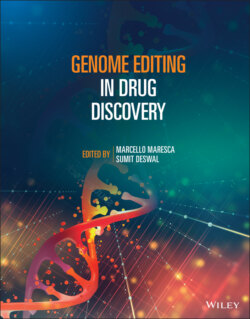Читать книгу Genome Editing in Drug Discovery - Группа авторов - Страница 70
4.5.4.1 Confirmation of Gene KO at Protein Level
ОглавлениеIdeally, gene KO clones with frameshift mutations should be further confirmed via protein analysis (e.g. Western) for depletion of the protein at the expected protein size, as long as a specific antibody is available. While this is observed for many genes in cellular KO experiments, deviations have been observed. In a recent study by Smits and colleagues, systematic characterization of frameshift KO mutations in HAP1 cell lines revealed that one‐third of the quantified targets were still detected at variable levels from low to original (Smits et al. 2019). Further studies of these frameshift KO clones, as well as other studies on genetically confirmed KO clones, revealed that residual levels of expression are either derived from introducing a premature stop codon, skipping of edited exon due to alternative mRNA splicing or from using an alternative initiation codon (Mou et al. 2017; Sharpe and Cooper 2017; Smits et al. 2019; Tuladhar et al. 2019). Dependent on the particular gene in study, and influenced by the location of the edited exon and the isoform expression profile in the cellular host, such truncated proteins may have full, partial, or even opposite activities (Smits et al. 2019; Tuladhar et al. 2019). Caution should be taken when interpreting KO effects of such clones. A practical approach to mitigate such effects is to analyze multiple independent clones derived from using gRNAs targeting different exons of the gene to obtain a concordant phenotypic observation. With a specific antibody, additional quality control assays can be carried out to analyze expression of the target protein in edited cells, including FACS analysis and cell staining. However, such assays only report on the presence/absence of the domain(s) the antibody recognizes, but not report on the size of the proteins/truncates detected, whereas Western analysis can report on both. Even with Western analysis, the results are impacted by epitope specificity of the antibody used. An N‐terminal‐specific antibody detects the full length and truncated proteins resulting from premature translation terminations; whereas a C‐terminal‐specific antibody enables detection of the full length and truncates resulted from in‐frame exon skipping as well as alternative translation initiations. In cases where a heterologous reporter gene (i.e. GFP, Luc) or an epitope tag is inserted in frame with an endogenous gene via knock‐in reactions, well‐validated reporter/epitope‐specific antibodies can be readily used in QC assays at protein levels.
